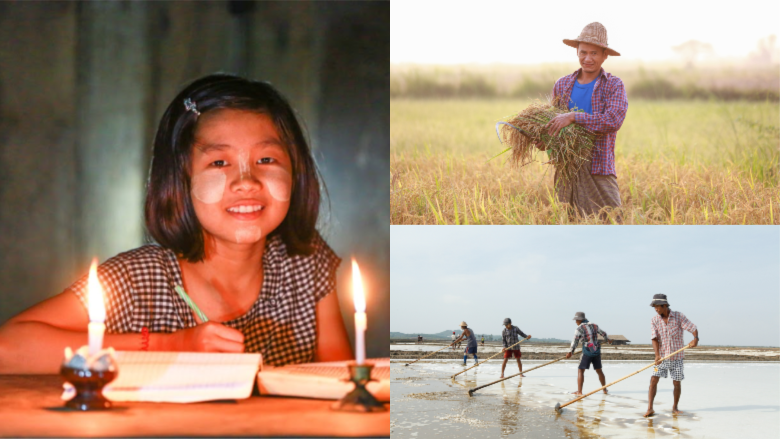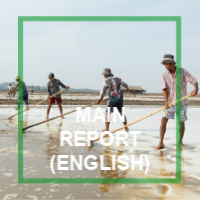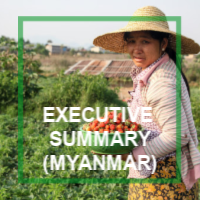Key Findings
The Sustainable Development Goals have made a bold commitment to end poverty in all forms and dimensions by 2030. This requires equally bold commitment by policy makers to better target the most vulnerable, increase access to basic resources and services, and support communities affected by conflict and climate-related disasters. In Myanmar, such policies and interventions will also be in line with the national development vision stated in the Myanmar Sustainable Development Plan.
A new report, jointly produced by the Department of Population under the Ministry of Labour, Immigration and Population and the World Bank, aims to formulate a multidimensional view on how deprived the people in Myanmar are, understand the intensity and determinants of multidimensional disadvantages, and provide a view of multidimensional disadvantage at the sub-national level, pointing to relative disadvantage of each Township in Myanmar.
What’s multidimensional welfare measurement?
- Multidimensional welfare measurement goes beyond one single measure of welfare (i.e. monetary poverty measures) and put a focus on the joint distribution of socio-economic indicators across the population.
- This means the study seeks to find out not only whether people are able to achieve minimum standards in, for example, health or education, but rather in both health and education. This also means that rather than individually examining whether people have been able to send their children to school, have access to improved water or have access to reliable lighting, multidimensional welfare analysis looks at all these areas simultaneously for a household.
Why multidimensional welfare measurement is needed for Myanmar?
- Myanmar is committed to pursuing the Sustainable Development Goals (SDGs), which include the aim to eliminate poverty in all dimensions by 2030 in the first Goal (SDG 1) In addition, several other SDGs directly focus on a number of dimensions; for instance, SDG 2 on hunger, SDG 3 on health, SDG 4 on education, SDG 5 on gender and empowerment, SDG 6 on water and sanitation, SDG 7 on energy, SDG 8 on growth and decent work, SDG 10 on inequality, and SDG 16 on peace and justice. Multidimensional analysis of welfare combines various dimensions of people’s well-being into a unified assessment.
Multidimensional Disadvantage Index in Myanmar
- The Multidimensional Welfare in Myanmar report uses detailed data available in the 2014 Myanmar Population and Housing Census, which covers a wide range of topics than most censuses. This includes demographic characteristics, disability and mortality, literacy and education, employment and education, housing conditions, as well as household assets and amenities.
- The 2014 Census covered the whole population within the borders of Myanmar, which in 2014 totaled 50, 279,900. An estimated 1,206,353 people (the vast majority in Rakhine, but also in Kachin and Kayin) were however not covered, limiting the ability to determine the extent of deprivations for populations living in those areas. The report is thus based on data pertaining to the 47,929,999 enumerated individuals, not including the institutional (2,349,901 people) and non-enumerated population.
- Myanmar’s national measure of multidimensional welfare is referred to as the “Multidimensional Disadvantage Index” (MDI). To adapt the needs of Myanmar, the report uses the term “disadvantage” to refer to deprivations in a particular domain or indicator—i.e. a household is considered to have a disadvantage if its members fail to meet a cut-off in an indicator.
- The MDI consists of 14 non-monetary indicators from 6 domains (education, employment, health, water and sanitation, housing and assets) chosen through a two-stage consultative process beginning in September 2017.
What are some key findings of the report?
- The study found 84 percent of population in Myanmar have disadvantage in at least one indicator and multiplicity of disadvantages is a very common phenomenon for many individuals. Only 16 percent of population have no disadvantage and 20 percent are disadvantaged by a single indicator. Nearly two-thirds (64 percent) of the population, however, are disadvantaged in at least two indicators, nearly half (47 percent) in at least three indicators, and more than one-fifth (22 percent) in five or more indicators.
- The divide in the level and intensity of disadvantage is substantial across urban and rural, and states and regions. The rural population is distinctly more likely to experience multiple disadvantages relative to the urban population at every level of cumulative disadvantage considered. The likelihood of disadvantage in 5 or more indicators for the rural population is 5 time higher than that in urban areas. At the states and regions level, Rakhine is the worst off in terms of multiplicity of disadvantage where 60 percent of the population experienced a disadvantage in 5 or more indicators. Kayin is a distant second with 36 percent of the population with a disadvantage in 5 or more indicators, while in Yangon only 10 percent fall into this category.
- Myanmar’s Multidimensional Disadvantage Index (MDI-1) is estimated at 20.7. This can be interpreted as the average person in Myanmar being disadvantaged in 20.7 percent of weighted indicators. There are large variations in MDI-1 across urban and rural areas, and across states and regions. The rural MDI-1 (at 24.6) is more than twice as high as the urban MDI-1 (at 11.2). Across states and regions, MDI-1 is the highest in Rakhine (39.2) and the lowest in Yangon (14). Other high-MDI states and regions are Ayeyawady, Kayin, Tanintharyi, Chin and Shan, while Mandalay, Kachin and Nay Pyi Taw are some of the low-MDI states and regions.
- However, there is no pattern of which domain or indicator mostly contributes to the total MDI across states and regions. Housing and Water and Sanitation are the biggest domain contributor in Rakhine but this is not the case in Chin where asset ownership plays the biggest role in explaining the total MDI. In Shan, on the other hand, education and water and sanitation domains contributed to a half of the total MDI, suggesting policymakers need to formulate policies and programs tailored to local needs.
- Spatial diversity of disadvantage occurs not just at the state and region level but also at the township level within each region. For instance, Kachin and Sagaing are relatively better-off states, but northern townships in both states have some of the most disadvantaged populations in the country. By contrast, while Yangon has the lowest MDI in Myanmar, there is a clear difference in the level of the MDI between urban Yangon and the rural townships located in the delta, close to Ayeyawady.
How does this report contribute to development policy in Myanmar?
- If development is viewed as the process of expanding people’s capabilities, an assessment of the current development challenges facing a country requires a broad-ranging review of how people are doing in various aspects of their daily lives, particularly in important domains such as education, employment, health, water and sanitation, housing, assets and basic amenities.
- The Multidimensional Welfare in Myanmar report provides useful information for development policy in three areas. First, MDI is a new measure of identifying people’s needs from various non-monetary perspectives and provides a multidimensional view of people’s well-being in Myanmar. Second, the study sheds light on spatial distribution of multidimensional welfare – in what areas the people of Myanmar are deprived and where they live. Third, the report informs the contribution of different domains or indicators to overall disadvantage, highlighting domains that need the most attention.




